Feelings in Places that Used to be Churches
 Sunday, July 15, 2018 at 05:46PM
Sunday, July 15, 2018 at 05:46PM
Continuing my explorations into the kinds of feelings we have in particular sorts of places, I am going to pivot from my previous discussion of feelings in libraries to feelings in a bookstore that has been set up in a converted church. The strange tension or offset in feelings between those we have in bookstores and those we have in churches helps to open up our awareness of the richness and complexity of both these kinds of feelings.
The town in the Netherlands where the bookstore is located also contains a famous hotel which has been set up inside the church attached to a former monastery. Once again, the offset of feelings between those natural to being in a church and those we associate with the public spaces of a hotel raises questions about the nature of both these sorts of feelings as well as the unique and somewhat strange feeling of being in a space which evokes both.
Particularly in Europe today there are far more old churches, especially in city centers, than there are worshipers to fill them. So, they have been converted in many cases to other uses. In addition to hotel and bookstore, in another town in the Netherlands there is one that has been converted into a museum for the history of mechanical and automated musical instruments. Perhaps most famously, in New York City there was in the 1980s a church that had been converted into a disco, Club Limelight. In each of these particular cases I have personally experienced the feelings evoked by these hybrid spaces.
In an earlier posting in this blog about feelings in rather dramatic spaces, I offered some comments and observations on feelings in the famous Sagrada Familia cathedral in Barcelona. I will be building on those in the current discussion. (See “Feelings in Places: Contradiction and Inspiration” January 5, 2018.)
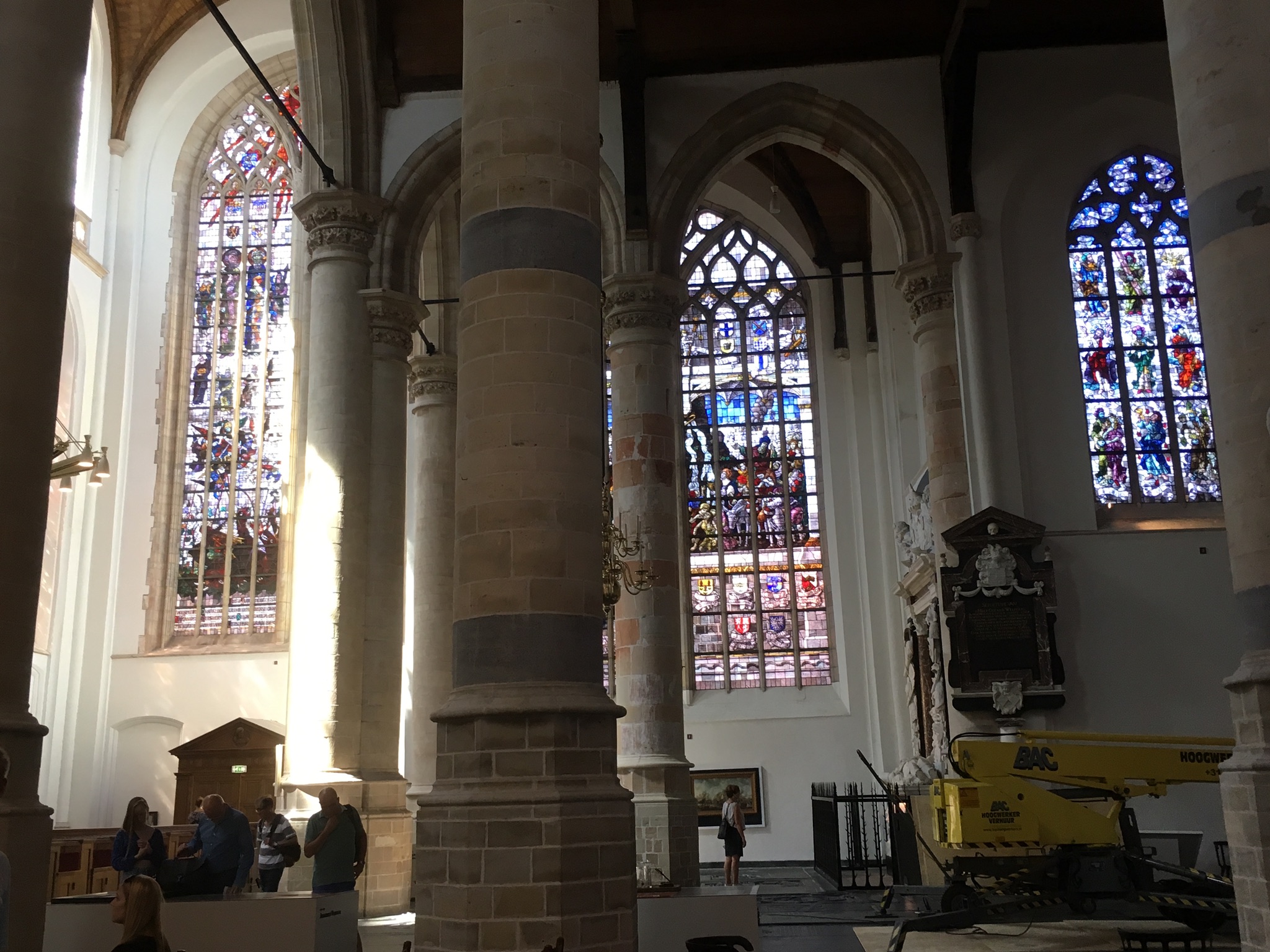 Oude Kerk, Delft
Oude Kerk, Delft
For the most part, the church spaces I will be talking about are those in the form of a Gothic cathedral. These spaces are among the most powerful and evocative achievements of Western architecture. Because they have such strong feelings associated with them, when they are hybridized with other radically different functions such as that of a hotel lobby, a bookstore, or a disco, the tension, contradiction, or what I will simply call the "offset" of the feelings that pull us toward one type of space or the other are dramatically magnified. In such hybrid spaces we have a unique opportunity to become more sensitively aware of the nature of these feelings.
As I have previously discussed feelings in the Sagrada Familia, which is a modern fantasia on the theme of the Gothic cathedral, and feelings in a variety of historical and contemporary libraries, it seems appropriate to begin with a Church-Bookstore.
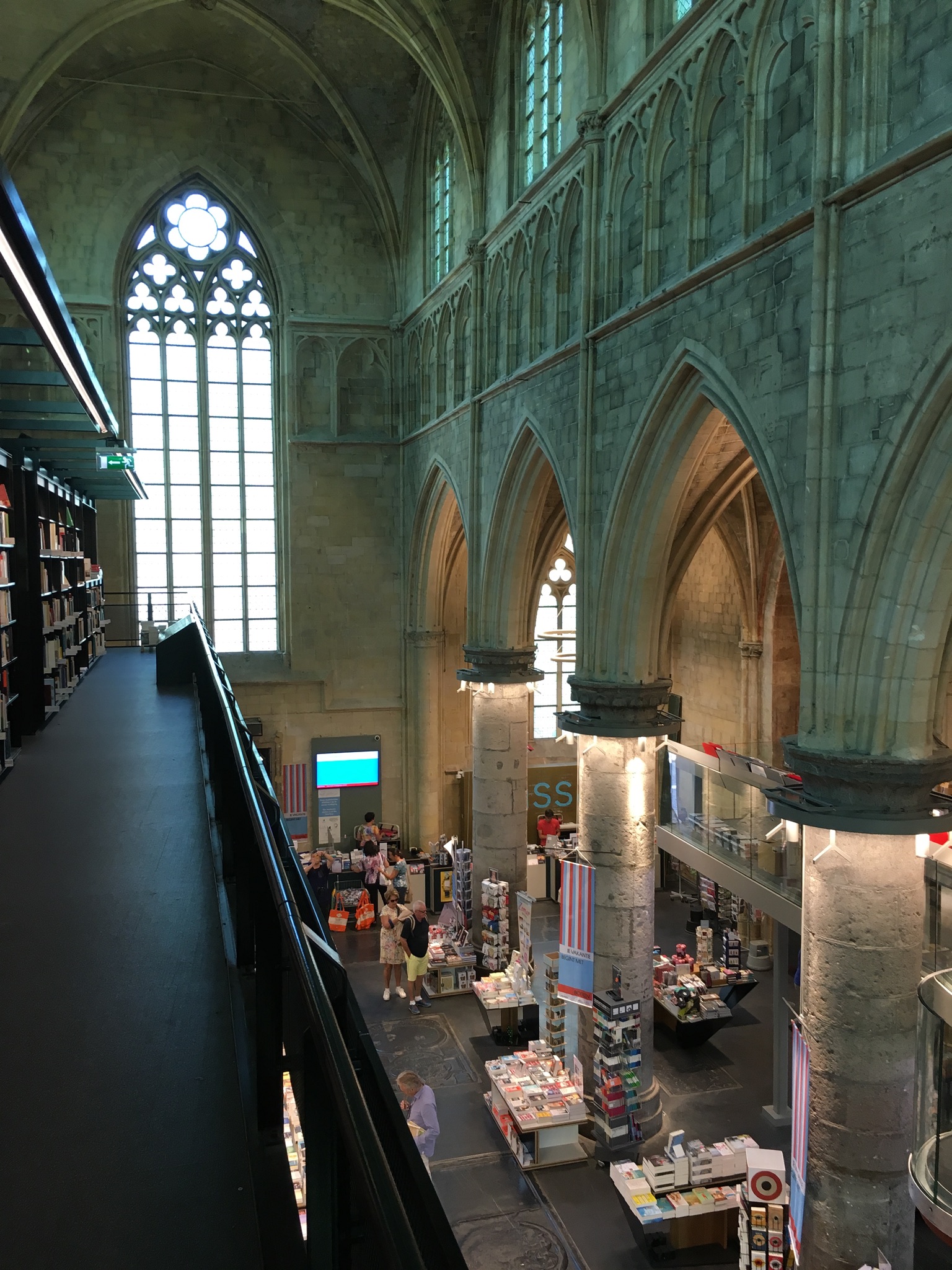
The Dominicanen Bookstore in the town of Maastricht in the Netherlands was constructed inside a 13th century Gothic cathedral. As also in the case of the Church-Hotel in the same town, the modern construction was designed to be free-standing inside the ancient building so as not to damage it or compromise its original architectural integrity. In the bookstore, there are the usual ranges of bookcases around the walls on the ground floor. But in the center there is a three-story steel construction with its own internal staircase to provide additional display and storage space for the bookstore.
Depending where you are in the church-bookstore your gaze may take in scenes that feel very normal for a modern bookstore, including a small coffee shop. Or it is possible to look in a focused way at the original Gothic architecture of the space, minimizing the intrusion of the bookstore elements. But most of the time your gaze encompasses both. Standing on the freestanding bookstore construction in the center, on the second or third level, you can look out at the longview of the original cathedral nave, or just at a short view through the steel bookstore construction to a Gothic stone window.
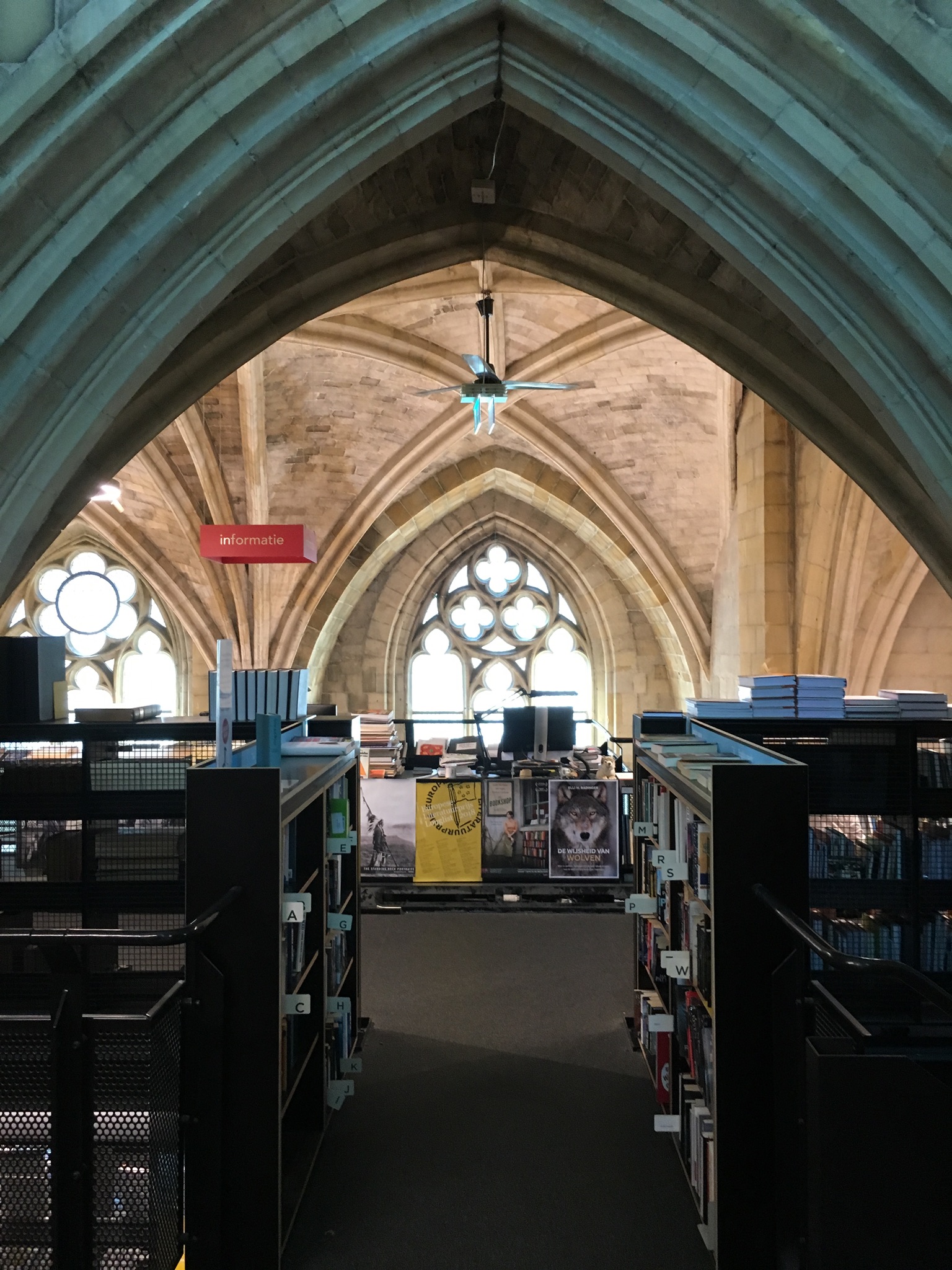
Now a bookstore is not quite the same as a library, though they have many elements in common. I think comparing the feelings one has in libraries versus bookstores can be somewhat illuminating. Libraries, particularly old ones, evoke feelings of quiet, age, and the accumulation of books and knowledge over very long periods of time (see blogposts “Chronopaths: Feelings in Libraries #1 and #2” from 2017). They feel somewhat solemn, not unlike churches, and evoke a feeling of hush and quiet. Bookstores on the other hand are busy commercial spaces, and their book stock tends toward the contemporary, including modern-looking editions of older classics. While you can seek out a quiet corner in a bookstore, people happily chat and joke with one another in a bookstore in a way that would not feel as comfortable in a library. The book publishing industry has acclimated us to the notion that reading books is a form of entertainment and buying books is a happy, casual leisure activity. The library on the other hand evokes more the sense of reading as a serious occupation.
Browsing books in the church-bookstore also produces predictable accidents of contradiction when we happened upon contemporary books whose themes and cover images, being particularly comical or perhaps sexual, seem especially out of place in a church. We will feel this again in the church-hotel where the presence of the bar, a visually prominent wine collection, or some slightly kinky works of art jar with the general feeling of being in a Gothic cathedral.
It is also the case of course that collections of books are not out of place in grand religious spaces, as many of the great old libraries of Europe were attached to monasteries, the seats of bishops in Cathedral towns, and universities which were originally built for the training of priests. Literacy was virtually a monopoly of the church in the Middle Ages. The preservation of literate traditions and culture was one of the great achievements of the church that built the great cathedrals of Europe.
But what about a Church-Hotel?
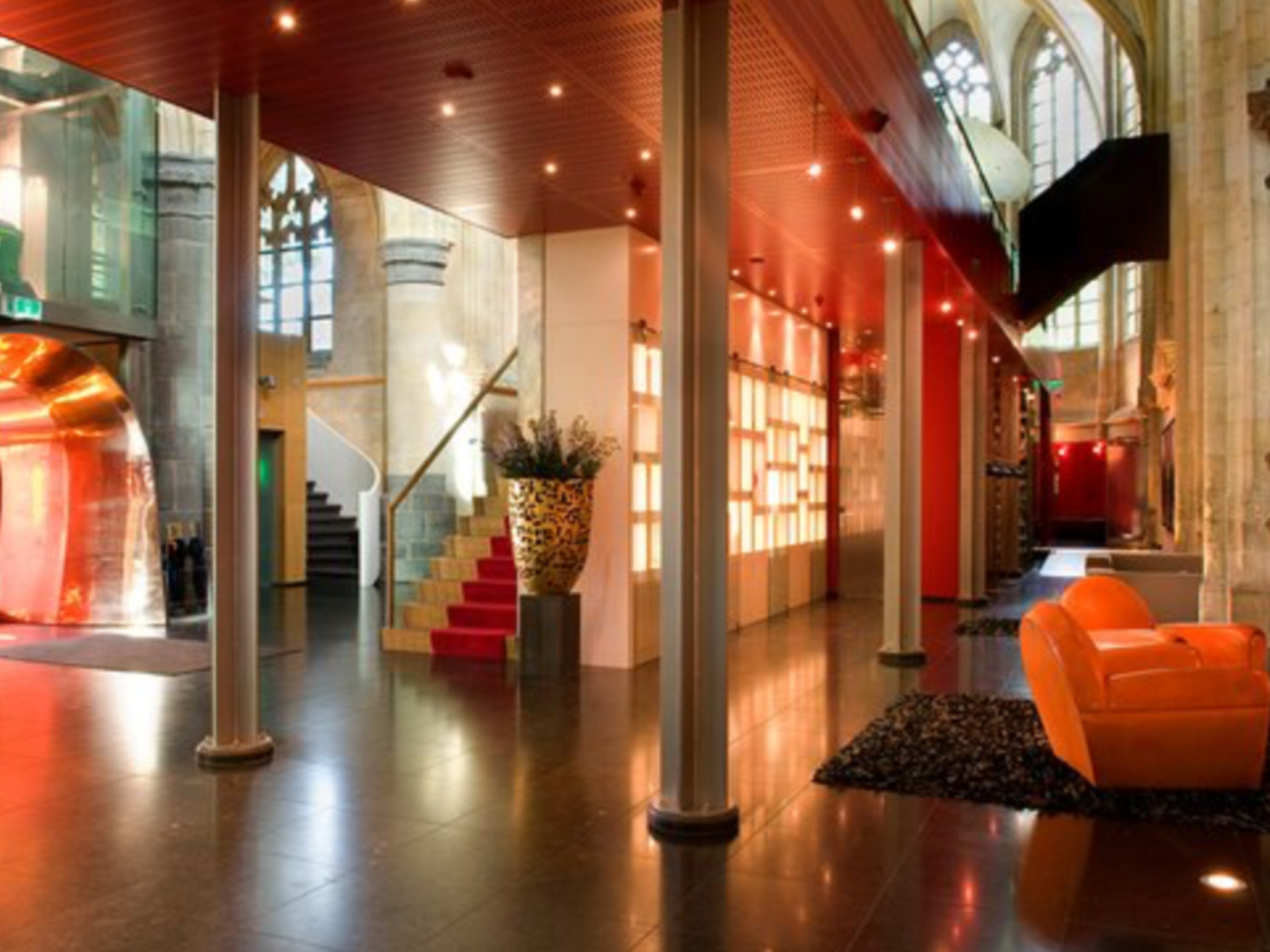
It is also true that monasteries and many churches have histories of offering hospitality and even sanctuary to travelers and refugees. One such former monastery in the town of Maastricht is now the Kruisheren Hotel. The image of the hotel lobby here provides an evocative mix of the Gothic cathedral elements and those of a familiar contemporary design-hotel lobby. Once again there is a freestanding construction in the center of the former church nave with its own staircase and some other ancillary constructions connected by glass bridges above the ground floor.
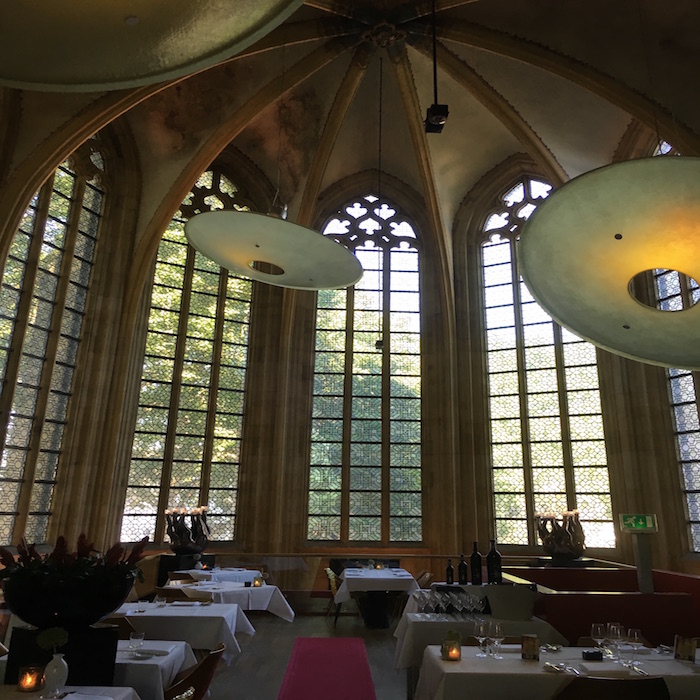
In the dining room the Gothic elements are especially prominent visually, dominating the space. Once again, we might reflect on the relationship between sharing food and church and monastic traditions.
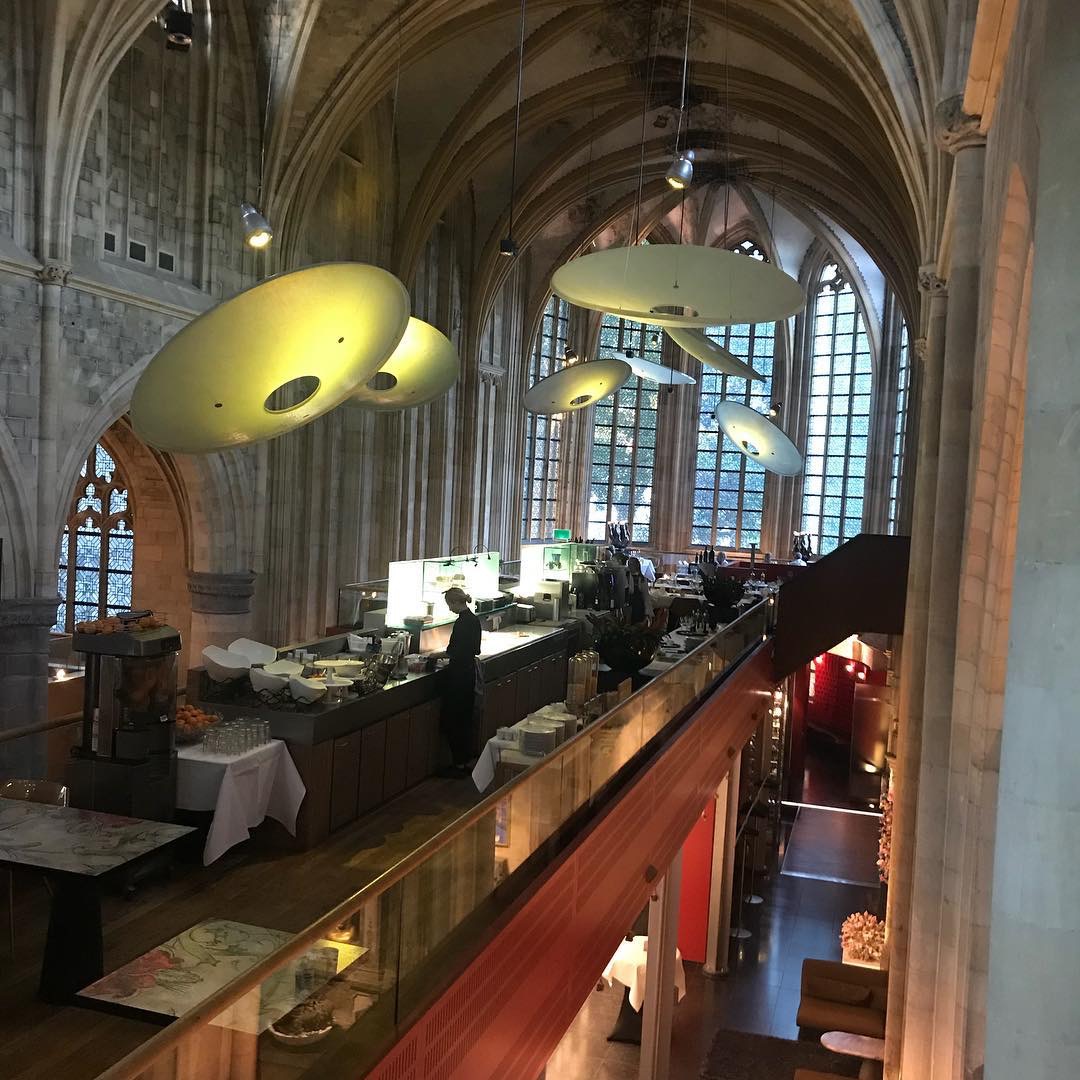
Still, as the longer view across the breakfast buffet towards the Gothic windows shows, being in this space is a thoroughly hybrid experience, at one and the same moment very modern and contemporary in facilities and function and yet still thoroughly embedded in the soaring and sacred architectural feelings of the Gothic cathedral.
Even more here than in the church-bookstore there is a sense of being in two feeling-spaces at the same time, which are in one sense a single space with a single complex hybrid feeling, and also two separable spaces that are somewhat offset to one another along a dimension we may not have realized even existed. A dimension in feeling-space in a different sense.
What are we to make of the modern architect’s free-floating flying saucer chandeliers in this space? They are clearly an attempt to bridge between the two feeling-spaces. Providing and reflecting light high up in the nave, which is a principle of Gothic architecture, and yet fiercely contemporary in their own design, almost as if flying saucers, aliens, and angels could be mashed up into a pointer along that new dimension in the hybrid feeling-space.
Now two more examples, one somewhat low-key and one more dramatic.
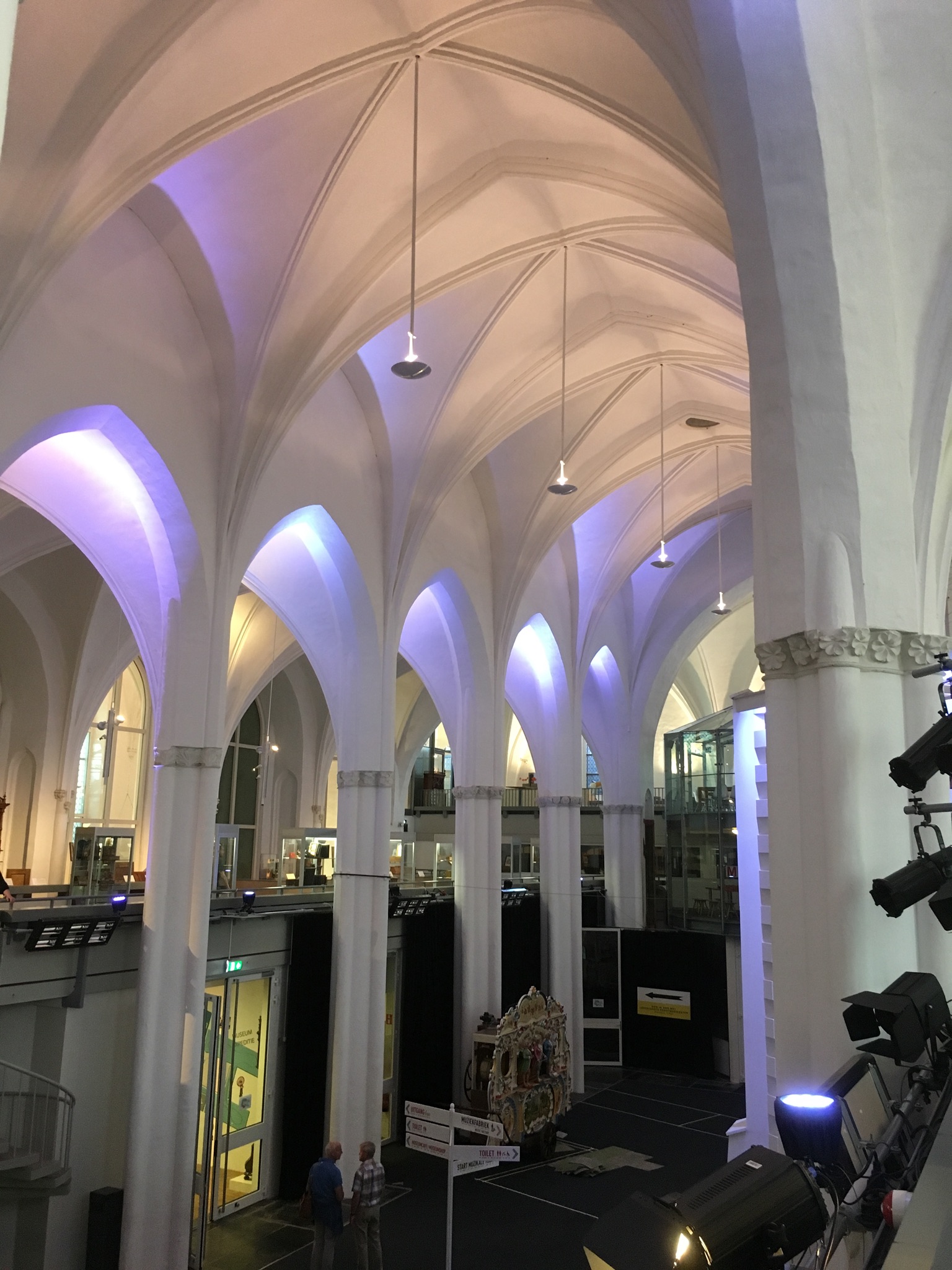
Yet another church in the Netherlands in the city of Utrecht has been converted into a museum (Speelklok Museum). It is a museum for the history of musical clocks, music boxes, player pianos, and far grander constructions and contraptions of the 19th century for making automated musical instruments and indeed whole orchestras run on crank power or steam power. In all cases these clock-like constructions were fully automated music players with melodies and harmonies determined by metal and paper rolls and metal plates coded with the appropriate notes and timing intervals.
Within this Church-Museum there is indeed at one end the great organ that one might expect, and it too probably has some player-piano like arrangement at its keyboard. As a museum, it is in many ways traditional, with long aisles of glass cases filled with the smaller instruments, chiming clocks, and music boxes, and larger rooms containing the much grander and often quite beautifully decorated orchestral contraptions. It also has a carillon in the interior space, natural perhaps for a museum, but reversing an inside-outside expectation for the church. Particularly from the upper-level balcony and looking up, as in the image here, we get a fairly strong sense of the gothic architecture of the space. Once again it is true that cathedral churches with their bells that played various melodies as well as ringing the hours were among the first to automate music playing. But on the other hand, many of the larger musical contraptions, some of which are as large as a good-sized truck, were characteristic in their own time of fairgrounds and dance halls, which were spaces evoking feelings very much at odds with those of a Gothic cathedral.
Museums and churches do perhaps share some feeling qualities in the same way as churches and libraries. Museums tend to be quiet spaces, spaces where we do a lot of looking and some learning, spaces in which various treasures are lined up for our gaze, not unlike the way in which chapels in cathedrals display paintings, stained-glass windows, and monuments to people long deceased, as well as some ecclesiastical treasures. Even so, there is once again the sense of an offset between our feelings of being in a museum space and our feelings of being in a church or cathedral space. We are more aware of each of these because of the contrast with the other. And yet if we spend long enough in these hybrid spaces, we realize that the feeling of the hybrid space is not a combination of feelings from other spaces, even though we may analyze it that way self-consciously and reflexively. The experiential feeling is a single feeling, if a strangely unaccustomed one.
Bringing us to our final example, the Limelight Club disco in New York.
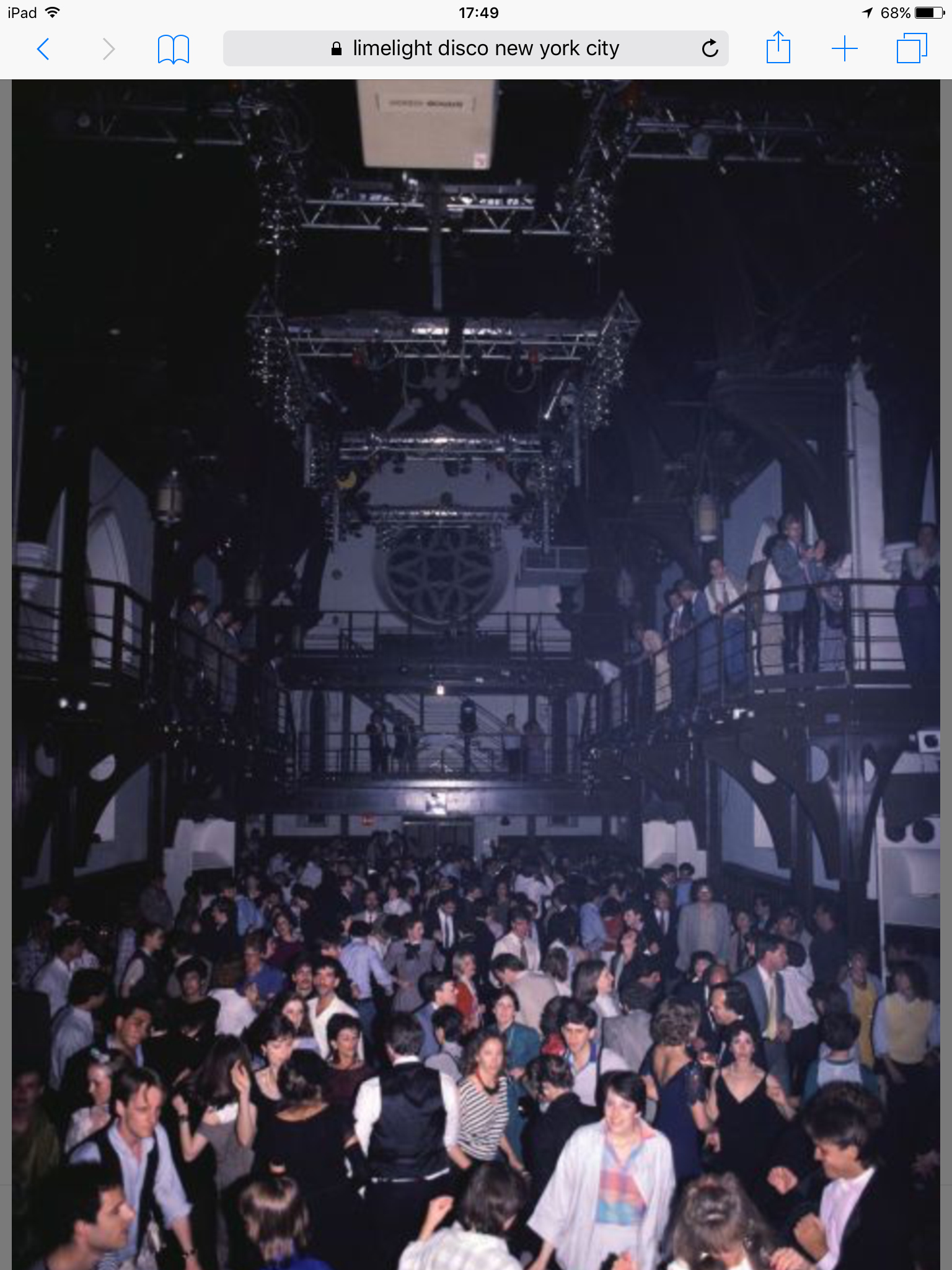
In the original disco the presence and feeling of the church was pushed into the background by the lighting and the intense feelings generated by the music and the activity of dancing. The disco was active mainly late at night and the interior was left dark except for dramatic spotlighting and strobe lighting or light show effects keyed to the music. The architectural elements of the church were everywhere, but often unlighted and in the dark. This was particularly true of the main dance floor space and its balconies, compared to some of the lounge rooms and hallways off to the side.
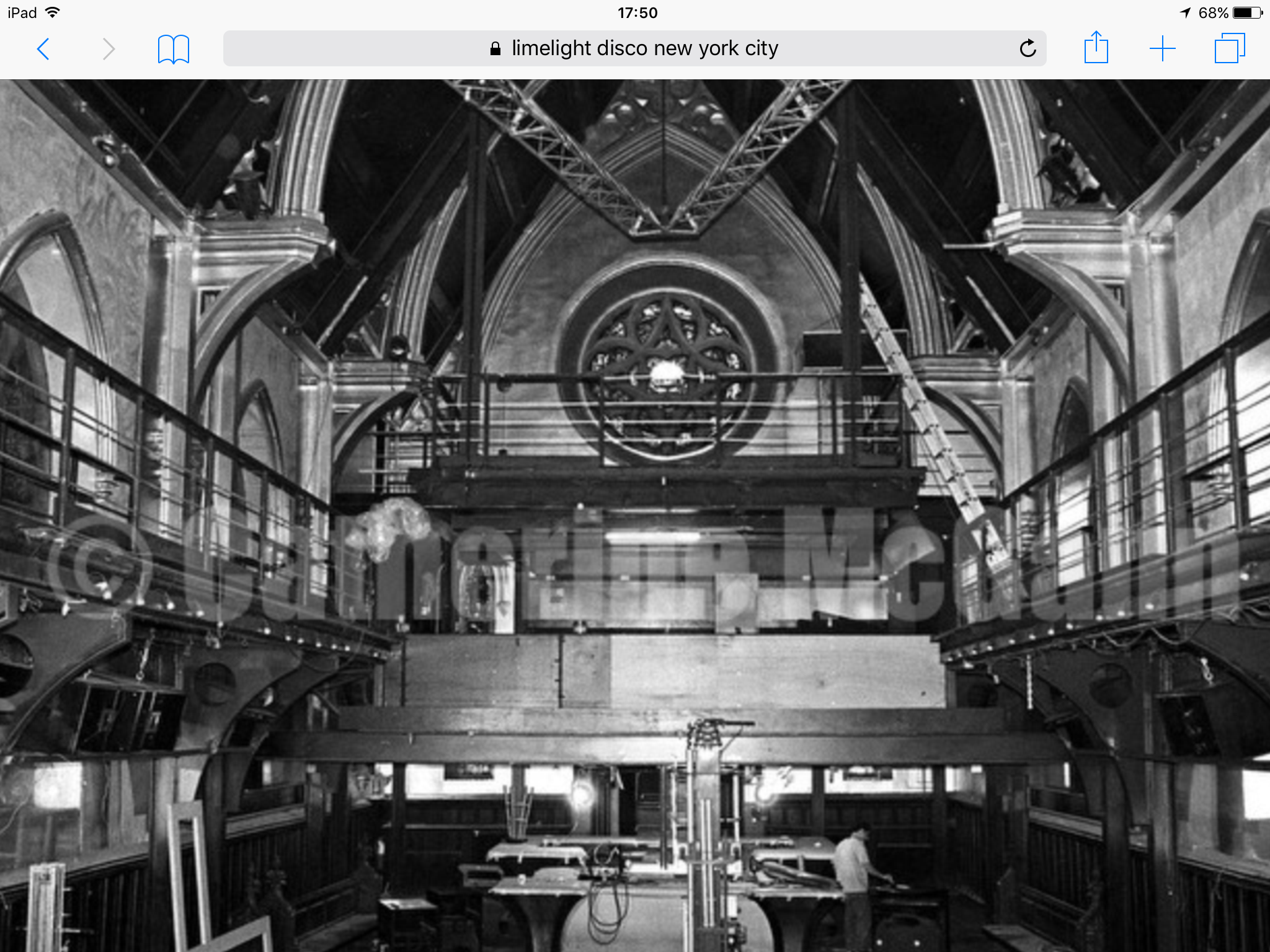
For comparison, we have an image showing the interior in full light during construction or reconstruction. Much more of the architecture of the church, a sort of neo-Gothic, is now visible and the contrast is between that and the very modern steel construction and technology.
The Church-Disco also reminds us that all these hybrid spaces are not just visual displays but true spaces through which we move in characteristically different ways. One walks slowly in churches, museums, and perhaps even bookstores, but you expect to dance and jump around in a disco. You can also shout and wave your arms about, and if you're going to talk you will most likely be doing it in quite a loud voice. Feelings in spaces are also a product of the activities we perform there or that we feel we might perform there.
In churches we listen, sit, observe, walk slowly, and perhaps sing or pray. In museums we walk, look, and perhaps read or quietly comment to someone. In bookstores we browse, read, buy, and perhaps chat or have a cup of coffee. In hotel lobbies, we stroll, sit, chat, meet people, and pass through on the way to somewhere else. The bodily components of our feelings are strongly influenced by these activities and our expectations about them. We do not normally imagine ourselves dancing in a church, and the music people danced to at Limelight was certainly not the music we expect to hear in a church, not even a very progressive one.
The ambient sounds of spaces are also evocative of our feelings in them. The sound inside a cathedral nave is quiet, echoing, and occasionally overlaid with the music of an organ. So different from the sound of a hotel lobby, or a 1980s disco. Sound, we realize also includes silences and the sense of an ambient sound-space so well known to the designers of concert halls and opera houses, but increasingly also of restaurants and schools.
In all the cases of hybrid spaces, the experienced feelings we have are unitary. We feel what we feel. The associations we form from these feelings may lead us to connections with churches, museums, bookstores, hotels, and discos. Different associations may lead us to an awareness of different dimensions within the single feelings that we have at single moments, and the evolving feeling-trajectories that develop over shorter and longer times in the course of our encounters with and activities within these spaces.
The feeling of being in a disco in a church, or in a hotel lobby within a cathedral space, is its own unique unitary and singular self, a feeling of a new kind, unfamiliar but at the same time capable of making the already familiar strange, so that we are all the more aware of how our more usual feelings feel, because they are now slightly offset to a new and hybrid feeling. Experiences in such spaces can be tools for probing more deeply into the richly complex dimensions of experiential feelings.
We may perhaps also realize that every space is in some way a hybrid space, that it evokes feelings and associations along multiple dimensions with the feelings we have had at other times and places in similar spaces. And every feeling is likewise felt at the intersection of chains of associated feelings, memories, imaginations, and experiences.
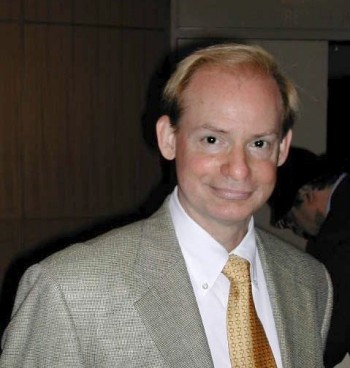
Reader Comments